




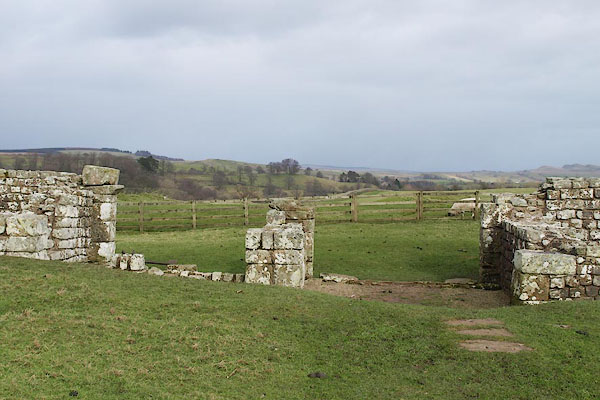
BOW12.jpg East gate.
(taken 21.3.2008)
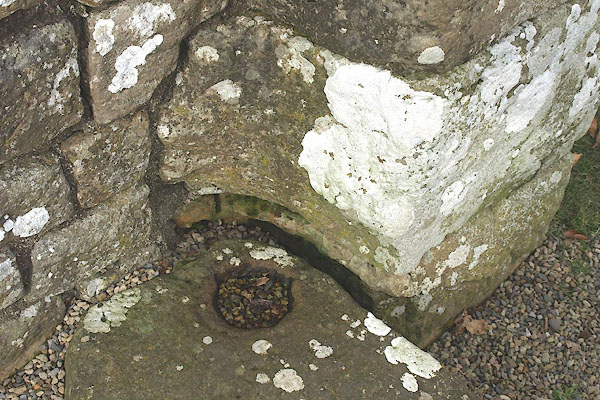
BOW13.jpg Pivot for one of the east gates.
(taken 21.3.2008)
placename:- Amboglanna
"Remains of Roman Station / AMBOGLANNA"
placename:- Voreda
placename:- Caer Voran
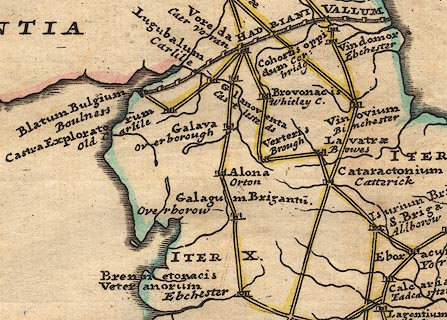 click to enlarge
click to enlargeStu1Cm.jpg
"Voreda / Caer voran"
item:- Hampshire Museums : FA2001.171
Image © see bottom of page
placename:- Amboglana
item:- roman inscription; inscription, roman
 goto source
goto sourceGentleman's Magazine 1744 p340. "MR URBAN, Carlisle, Apr. 18, 1744"
"THE following Inscription was this Day found in a Wall of Geo. Wright's House, at Naworth, where it must have laid 200 Years at least, the House being so decay'd with Age, that it was absolutely necessary to rebuild it."
 click to enlarge
click to enlargeG744E01.jpg
"LEGIO SEXTA VICTRIX PIA FIDELIS FECIT."
"Mr Horsley conjectures that most of the Inscriptions in the Walls of Naworth*Garden and about it, were fetch'd by Ld William Howard, a great Antiquarian, from Burd-Oswald that celebrated Station on the Wall, which the Britannia Romana calls Amboglana, about three Miles distant from Naworth; the Stone does not appear to have been any larger, and we have Instances of like Inscriptions found at the same Place. That Legion was certainly in Britain at the Building of the Wall, or soon after; for in the Notitia most of the Stations are garrison'd with Foreigners, and the said Burd Oswald, with the 1st Cohort of the AElia Daecorum."
"Yours, &c. G. SMITH"
"*A Seat of the Earl of Carlisle, who is very curious in Matters of Antiquity."
placename:- Caer Vorran
 goto source
goto sourcePage 1025:- "..."
"At Kirkby-Thore begins the old Causey called the Maiden Way, which runs twenty Miles from hence to Caer Vorran near the Picts Wall."
placename:- Amboglanna
item:- roman altar
 goto source
goto sourceGentleman's Magazine 1752 p.105 "Mr URBAN,"
"IN a journey to the north of England, in August last, I had the opportunity of observing some of the remains of the Roman walls in that country, and of particularly examining several of the ruined stations belonging to them. I had no thoughts, then, of troubling you, or any one else, with my sentiments concerning any pieces of antiquity; my intention, at that time, reaching not farther than my own amusement. If I had, I might in some respects, perhaps, have been more exact; but I believe, I may venture to say, that in the copies of the following inscriptions no mistake has been committed that is material. I met with them at Burdoswald and Carrvoran, formerly the stations of Amboglanna and Magna; and since they have not, as far as I know, been yet made publick; if you think proper to insert them in your Magazine, they and the observations upon them are at your service."
"(See VOL.XVI. p 358)"
"I am yours, &c. FRANCIS SWINHOW."
"Coll. of Edinburgh, 13 Jan. 1752."
item:- inscription, roman; roman inscription
 goto source
goto sourceGentleman's Magazine 1752 p.106 "OBSERVATIONS on five Roman inscriptions after the manner of Mr Horsley."
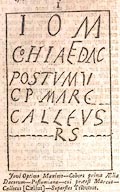 click to enlarge
click to enlargeG752E01.jpg
"Jovi Optimo Maximo - Cohors prima AElia Dacorum - Postumiana - cui praeest Marcus - Callecus (Caelius) - Superstes Tribunus."
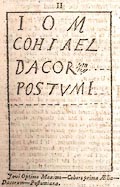 click to enlarge
click to enlargeG752E02.jpg
"Jovi Optimo Maximo - Cohors prima AElia - Dacorum - Postumiana."
"I, II. THE two first are standing in the yard belonging to the farm house at Burdoswald. I understood from the people of the place, that they had dug them up about four or five years ago, within about a stone's throw of the wall of Severus, and a little to the east of the station. They are both to Jupiter the best and greatest, by the Cohors prima AElia Dacorum, which Cohort is well known to have been stationed at this place. The letters do not seem very well cut, and yet are not so rude and uncouth, as they are in many other inscriptions. They are, however, very differently disposed in them, tho' the stones seem to have been inscribed within a few years of one another. In the first the O is in the belly of the C in Cohors, and the E and L in the same line are joined together by a ligature; and DAC is put for Dacorum. In the second there is no such inequality of the letters, and the word Dacorum has been at its full length. The reason of this I take to be, that in the second the name of the commander of the Cohort has been shorter, than in the first, where it seems to consist of three distinct words, to make room for which, the stones being of the same size, what fills up the second and third line in the other is in this crowded into the second. Hence it appears that this Cohort must have had two commanders, at least (tho' the name of one of them we do not know) during the seven (a) years of Postumius's power over the western parts of the empire. For I make no doubt that the third line in the first, and the fourth in the second inscription is to be read Postumiana, and that the Cohort has this appellation from its taking part with Postumius one of the thirty tyrants, whose government was acknowledged thro' all Gaul and Britain, and whose coins are frequently found in our island. We have a short account of him and his son in Trebellius Pollio (b). In other inscriptions we find this Cohort called Gordiana (c) from the emperor Gordian, and Tetriciana is given us only by Mr Horsley (d), and I think it is well supported by the two inscriptions that we are now considering, which, and those two just now referred to, seem mutually to throw light upon and confirm each other. The name of the commander in the first inscription seems to have been Marcus Callecus Superstes, or perhaps Marcus Coelius Superstes; for it is not unlikely, that the first appearance of an L has been really an E, and I am apt to think that I have made some mistake in the fifth letter. But, be this as it will, tho' in the next line with only RS, it does not seem to be too hasty a supposition, that the word has been Superstes, as before the R there is just space enough for the four first letters, and after it for the three last. We have the same Cognomen in other inscriptions (e); and Marcus Coelius Superstes"
"(a) Hic vir in bello fortissimus, &c. talem se praebuit per anos septem, ut Gallias instauraverit &c. Trebell. Poll. Trigint. Tyrann."
"(b) Ibid."
"(c) See Cambden, pag.1039, and Horsley's Britannia Romana, Cumberland VII, and VIII."
"(d) Ibid p.253."
"(e) See Gruter; Gordon's Itenarium Septentrionale pl.33, fig.1. p.75; and Horsleys's Brit. Rom. Northumberland, xxxvi, and lxxxvi."
 goto source
goto sourceGentleman's Magazine 1752 p.107 "perstes is a name that occurs in Gruter (f)."
"The appellation Postumiana ascertains the time of these inscriptions, for Gallienus began to reign alone about the year 259, which, as appears from Trebellius Pollio, was before Postumius was made emperor in Gaul (g). We may therefore reasonably suppose the time of these inscriptions to have been between the years 260 and 267 or 268. I chose Tribunus to compleat the first inscription, because in other inscriptions, this Cohort appears to have been commanded, not by a Praefect, but by a Tribune (h). Of these stones I have only taken the planes, on which the inscriptions are, as I saw nothing else observable in them. The ligature of the EC, if I have taken that part of the first inscription right, is worth observing."
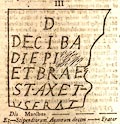 click to enlarge
click to enlargeG752E03.jpg
"Dis Manibus - - - Et - Stipendiroum Annorum decem - Frater"
"III. This stone lies upon a wall just by a gate at a little distance from the station westward. The letters are well cut, and are deep in the stone. Half of it, if not more, seems to be broken off; so that very little can be known about it, which is a great pity. However, it plainly appears to have been a sepulchral; but of the DM for Dis Manibus the D only is left on the top. An inscription in Gruter tells us of a Cohors Bracarum that was once in Britain (i); but that the same Cohort is intended here under the name Braecarum, I will not say. All that can be said about it is, that the person, to whom that belonged, seems to have served ten years in the army, and that it has been erected to him by his brother. For STAX seems to denote Stipendiorum Annorum decem; and the last four broken letters of the last line plainly appear either to have stood for Frater, or to hev been part of the whole word. The stroke near the T, in the last line but one, seems only to be an accidental scratch upon the stone."
the other inscriptions are from outwith Cumberland.
placename:- Amboglanna
 click to enlarge
click to enlargePEN1Cm.jpg
"Amboglanna"
square; roman camp on Hadrian's Wall
item:- private collection : 66
Image © see bottom of page
placename:- Burdoswald roman fort
placename:- Amboglana
item:- inscription, roman; roman inscription; roman altar; altar, roman
 goto source
goto sourcePage 205:- "..."
"Burdoswald, in Lanercost parish, a very large and remarkable fort, at which more inscriptions have been found than at any other Roman station, was the AMBOGLANA of the Notitia, the station of the cohors I Elia Dacorum. Many of the stones found here having been brought over the river to Willoford, that place has without reason been supposed a station; for there are no such appearances. Ford and Worth are often confounded. Volurtium Raven. is on the altar Volantium. Of the inscriptions given by Mr. Camden the 3d, 7th, and 8th, are at Rookby, from Naworth, the first was at Naworth, Horsley's Cumb. xi. the 2d, if it was not a large low altar now in a corner of a house at Willoford, is lost; the 4th seems to be on an altar at Corby castle, Horsley's Cumb. xvi. and to be read Pro salute D N Maximi ac fortissimi Marii Aurelii Maximiani... aedificavit. The focus is very particular. The 5th is Horsley's Cumb. xxiv. p.259 at Naworth. The 6th was built up in the front of a house within the fort at Burdoswald. At Willoford were the altars, fig.12, 13. Pl.XIV. with other stones that have the centurial mark, or are uninscribed. At Underhaugh, a house between Burdoswald and the Irthing, was fig.14. Pl.XIV. and within the fort, fig.15. and fig.11. Fig.1 Pl.XV. was in a garden or yard wall on the south side of the fort: fig.2. is Horsley's XIII. fig.3 his XII. fig.4 his XIV. Fig.6 Pl.XV. was on the front wall of the principal house at Murray, a village a quarter of a mile east from Burdoswald. The stone inscribed DADA is in a house in the fort: two others. Some centurial stones COH. viiii. were at Lanerton, a mile west from Burdoswald. Above 100 yards without the fort eastward in a kind of ruin were dug up two more altars, with inscriptions, communicated by Mr. George Smith to Gent. Mag. 1746, 538. engraved Pl.XV. fig.7, 8. They recite the Cohors I Elia Dacorum Postumiana."
 goto source
goto sourcePage 226, Mr Horsley:- "..."
""The fort of BURDOSWALD stands upon a large plain, at the head of a steep descent towards the river, having the out-buildings chiefly on the south-east. Severus's wall (which before it reaches the fort is in the third degree, though the ditch be only in the second at the most) forms the north rampart of this station; and Hadrian's vallum, which is lost near the fort, must have fallen in with the southern. The foundations of the houses within this fort are very visible. I measured the thickness of their walls, and found them to be about 28 inches, and the distance or breadth of the passage between the rows of houses or barracks to be no more than 32 inches. The ramparts about the fort are in the third degree, and the ditch in the second, excepting on the north side, where it is not so much. The foundation of the west rampart is distinct, and measured about five foot. There are regular entries visible on the north and south sides, opposite one to another, as also faint appearances of entries on the east and west. In the northern part of the station there seem to be the remains of a temple. The turrets in the south rampart on each side the gate are still very visible; and over-against the entry are the ruins of the praetorium, on which a house or two stand at present."
placename:-
item:- roman inscription; inscription, roman; roman altar; altar, roman
 goto source
goto sourcePage 177:- "... on the wall Burd Oswald. Below this last, where the Picts wall crosses the river Irthing on arches, was the station of the cohors prima AElia Dacorum, at a place now called Willoford, as appears from the Notitia, and from several altars dedicated to Jupiter Optimus Maximus by the said cohort, of which I shall subjoin the following though almost defaced by time:"
"I. O. M.
COH. i. AEL.
DAC. CVI...
PRAE...
IG......
......
......"
"I. O. M.
OH i AEL. DA
C... C.. A GETA
IREL SAVRNES
......
......
......"
"I. O. M.
CoH I. AEL
DAC. C. P.
STATV LON
GINVS, TRIB."
"PRO SALVTE
D. N. MAXIMANO
[*] FOR... CAE
VA......
......
...... OAED"
"LEG. VI
VIC. P. F.
F."
"I. O. M.
COHI. AEL. DAC.
TETRICIANO RO
... C. P. P. LVTIC
... VS. DESIG
NATVS
TRIB."
"I. O. M.
COH. I. AEL
DAC. GORD.
ANA. C P. EST."
"I. O. M.
... H. I. AEL. DAC.
... C. PRAEESI...
... FLIVS FA
... S. TRIB...
... PETUO...
... COS......"
placename:- Birdoswald
placename:- Amboglana
 goto source
goto sourcePage 115:- "of Denton and Lanercost. The antiquarian will prefer travelling from Lanercost to Gilsland, along the heights of the northern bank, as he will have an opportunity of examining the Roman Wall, more especially at Birdoswald, the Amblogana of the Romans, where the mass of the wall is visible, though its facings are gone."
item:- inscription, roman; roman inscription; coin, roman
 goto source
goto sourceGentleman's Magazine 1844 part 2 p.295 "Mr. Smith read an extract from a letter from Mr. R. Weddell, of Berwick-upon-Tweed:-"
"..."
"At Burdoswald another stone has been recently found, but the inscription is much defaced, and part of the upper side has been lost. All I can make out of it is,"
 click to enlarge
click to enlargeG844E03.jpg
"The tenant also shewed me a small brass coin of the emperor Licinius, much defaced, which he lately found on his farm. The entrance to the camp through the west wall is distinctly seen, and about midway between it and the wall to the north are several large stones clasped together with iron rods.""
placename:- Amboglanna
 goto source
goto sourceGentleman's Magazine 1851 part 2 p.506 "..."
"The traveller on leaving Carvoran will, from necessity, rest at Glenwhilt, a village at no great distance on the line of the Newcastle and Carlisle railway. He will then be prepared to encounter the somewhat difficult access to Birdoswald, (Amboglanna,) one of the noblest of the stations of the wall. To avoid a very circuitous route the river Irthing must be forded, and the steep banks of a ravine covered with thickets and underwood must be surmounted. Under the most favourable circumstances this is a serious task. With us it was rendered more formidable by the rain, and, had not our fearless guide animated us by example, we should possibly have remembered the warning precept of Hodgson, that "the attempt is very dangerous, and should never be tried by those whose life and existence are in any way useful." The site of the station is one of great natural strength, as on every side except the west it is protected by deep scars and inland cliffs, and by a detour of the Irthing. Amboglanna was the head quarters of the first cohort of the Dacians, styled AElia, probably in compliment to Hadrian, and subsequently termed in addition, Gordiana, from the Emperor Gordian, and Tetriciana from Tetricus the successful usurper in Britain and Gaul in the time of Claudius Gothicus and Aurelian. Numerous inscriptions have been dug up in and about the station. One is built up in a wall of the farm-house within the area, and fragments of others are lying about the garden. Most of these are dedications to Jupiter. Others record the second and sixth legions. We were gratified with the sight of a fine piece of sculpture three feet high, in the farm-house, representing one of the Deae Matres. The goddess is repesented seated in a chair and covered with drapery, the folds of which are very elaborately worked; the hands, which probably held a basket of fruit, and the head, have been broken off. But since our return Mr. Bruce has found the head in the possession of a person at Newcastle, and a hope may now be entertained that head and body will be united in the museum of the antiquaries of Pons AElii. ..."
placename:- Amboglanna
 goto source
goto sourceGentleman's Magazine 1851 part 1 opp p.149
 click to enlarge
click to enlargeG851E01.jpg
"AT THE STATION OF AMBOGLANNA"
 goto source
goto sourceGentleman's Magazine 1851 part 1 p.149 "... The first is a view of the junction of the west wall of the station Amboglanna with the great wall, to show the different character of the stones used in the two structures. (See the Plate.)"
 goto source
goto sourceGentleman's Magazine 1851 part 1 p.150 "..."
"The Vignette subjoined to this article (in p.154) represents the western portal of the station Amboglanna, now called Birdoswald, as seen from the inside."
""It exhibits the pivot-holes of the gates, and the ruts worn by the chariots or wagons of the Romans. The ruts are nearly four feet two inches apart, the precise gauge of the chariot-marks in the east gateway at Housesteads. The more perfect of the pivot-holes exhibits a sort of spiral grooving, which seems to have been formed with a view to rendering the gate self-closing. The aperture in the sill of the doorway, near the lower jamb, has been made designedly, as a similar vacuity occurs in the eastern portal; perhaps the object of it has been to allow of the passage of surface water from the station. The whole of the area of the camp is marked with the lines of streets and the ruins of buildings.""
 goto source
goto sourceGentleman's Magazine 1851 part 1 p.154 ".."
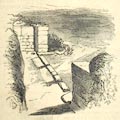 click to enlarge
click to enlargeG851E13.jpg
"WEST PORTAL OF AMBOGLANNA (FROM THE INSIDE)."
"(Described in p.150)."
placename:- Amboglanna
 goto source
goto sourceGentleman's Magazine 1852 part 1 p.483 "..."
"A SECOND LATERAL GATEWAY IN THE STATION OF AMBOGLANNA, BIRDOSWALD. - The stationary camps on the line of the Roman wall are constructed very much upon one uniform plan. Amongst other things, they seem to have been provided with a gateway in the centre, or near it, of each side. The gateways are usually double; a pillar of strong masonry separating the entrance into two parts. Each part has been closed by folding doors, as is proved by the pivot-holes which remain.*When the eastern and western gateways of Birdoswald were recently exposed by Mr. Potter, some surprise was expressed that they should consist of only a single portal. The reason of this is now made apparent. There are two distinct gateways in the eastern side, and also probably in the western. The farm-tenant, requiring stones to build a fence (so we were informed on the spot) began to remove the loose materials which incumbered the eastern wall of the station. The result of his operation has been to display a gateway in a most satisfacctory state of preservation. It is situated as far from the north wall of the station as that formerly discovered is from the south (68 yards) while there is a space of about 60 yards between them. This gateway, as well as that already exposed on the western side, as also each of the portals of the south gateway, which is double, is about 11 feet wide. The masonry of this gateway stands nearly six feet high; the pillars which form the jambs of the gate are, as usual, composed of stones of cyclopean character: several voussoirs and a springer lie upon the ground, thereby proving that the gateway has been spanned by an arch. It would seem also as if a separate opening had been provided for foot passengers, for a large stone with a semicircular cutting in it, two feet wide, has been found, which may have been used as the arched heading of such a passage."
"It is most satisfactory to know that the farmer has procured a sufficiency of stones for his purpose without disturbing one in situ. For the first time probably since the Romans abandoned Britain the wants of the rural population have contributed to the advancement of our knowledge. The party deserves all praise for the intelligence which he has exhibited in his operations. - Yours, &c."
"JOHN COLLINGWOOD BRUCE."
"*In our review of the Account of the Roman Wall published by our Correspondent, we extracted his view of the West Portal of Amboglanna. See our Magazine for Feb. 1851, p.154. - Edit."
item:- Deae Matres
 goto source
goto sourceGentleman's Magazine 1852 part 1 p.175
Report of a meeting of the Society of Antiquaries, 8 January 1852:- "Mr. C. R. Smith also exhibited a drawing of the head of a female seated figure, excavated by Mr. H. G. Potter at Birdoswald. The head is draped and crowned with a wreath, and the body enveloped in ample vestments. Mr. C. R. Smith considers the figure to represent one of the Deae Matres, or possibly the Magna Mater."
 goto source
goto sourceGentleman's Magazine 1853 part 2 p.391 "... ..."
"New discoveries are continually being made along the line of the Roman Wall. ... Birdoswald (Amboglanna), under the auspices of Mr. Glasford-Potter, is also disclosing its long-concealed treasures, among the last of which was a valuable inscription recording the cohort of Dacians, surnamed, from Hadrian, the AElian. ..."
 goto source
goto sourceGentleman's Magazine 1853 part 1 p.128 "..."
"... One of the most interesting features of the excavations at the latter place [Birdoswald] is the doorway leading from the northern gate-"
item:- clay pipe; tobacco
 goto source
goto sourceGentleman's Magazine 1853 part 1 p.129
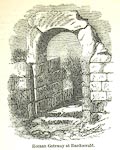 click to enlarge
click to enlargeG853E06.jpg
"way to the guard chamber shewn in the annexed cut. The circular door-head is formed of a single block of stone, which had been broken and thrown from its original situation. Similar stones have often been found near the gateways of stations, and their use is now fully determined. In the department alloted to minor antiquities will be found many objects of interest. With respect to the little tobacco-pipe bowls, we may observe that their comparative diminutive size may well be explained by the fact that in the time of Queen Elizabeth tobacco was sold at five guineas the ounce, and that in after-times those who indulged in the expensive luxury of smoking were accustomed in buying it to throw five shilling pieces into the opposite scale."
"..."
 goto source
goto sourceGentleman's Magazine 1853 part 1 p.73 "SOCIETY OF ANTIQUARIES OF NEWCASTLE-UPON-TYNE."
"..."
"Mr. H. G. Potter read a paper on his recent excavations at Burdoswald, which have brought to light a fourth gateway, far surpassing the others in style of architecture and finish. The first trace of it was discovered during the last winter, by Mr. Boustead, the farmer on the spot, who cane upon one of the piers while digging the foundation of a bull-shed. Mr. Potter, with his brother, subsequently assumed the work of excavation; and the result of their labours may now be seen by visitors. A noble double gateway has been laid bare. One of the gates has been walled-up, not by the Roman themselves, as is proved by the difference of level between the floor of the Romand gate and that on which the barrier now stands. Many circumstances, which presented themselves during the researches at Burdoswald, have led Mr. Potter to believe that this camp was occupied as a town long after the departure of the Romans. The floors, for example, of some of the houses are about four feet above the flagged Roman footpath inside the walls; and the ruins of (apparently) Roman structures form the foundation of later edifices - which, in their turn, have been destroyed, or suffered to go to ruin, and earth and herbage cover their remains. Gildas and Bede tell us in what manner the Picts and Scots conquered the Britons after the last Roman legion had left the island, and how they ravaged the country, drove the inhabitants before them, and made their habitations like the abodes of wild beasts; and tradition adds, that near Burdoswald (Amboglanna), at a place called "The Gap," the Picts broke through the Wall. The station, it is probable, was reduced to ruins, and so remained until the country became more settled; when, tempted by its commanding position, and the fact of its being traversed by the Maiden Way, some Saxon chief of the name of Oswald may have repaired its walls and gates, and built a town within - the Burgh of Oswald - easily corruptible into Burdoswald, Birdoswald, or (as it is now often called) Bridussel. Here also, there is reason to suppose, the Danes more recently dwelt. The wreck of Harrows (or Harold's) Castle still survives. Its stones were removed"
 goto source
goto sourceGentleman's Magazine 1853 part 1 p.74 "some years ago to build the Hill Head House, now occupied by Mr. Ramshay."
"In Mr. Potter's quarto tract on Aboglanna, printed in 1851, is a restoration of the "Decuman Gate," in which he has thrown arches over the gateway; and the truth of the vision which, with learned and sagacious eye, he then imagined, has been vindicated by his late discoveries. To one of the piers of the gateway, 81/2 feet high, the projecting impost is still attached, and the first stone of the arch rests thereon. The voussoir is two feet long, and 15 inches thick at the broad, and 111/2at the narrow end. At the outside of the southern tower of the gate, on the ground, was found a broken slab. It appears to have fallen from its place, and to have been fractured by a stone which had afterwards fallen upon it - and which, indeed, was found lying upon it still. This slab bears an inscription which may be thus given (two or three of the letters being conjectural):-"
"SVBMO DIO IV
LIO LEG AVG PR
PR COH I AEL DC
CVI PRAEEST M
CL MENANDER
TRIB"
"Mr. Potter extends the inscription as follows:- "Sublimo Dio Julio Legato Augusti Propraetori Cohors Prima AElia Dacorum cui praeest Marcus Claudius Menender Tribunus." Julius Severus, the noble Roman who he supposes to be here named, was propraetor of Britain in the time of Hadrian, and was recalled, as "the most courageous of his generals," to go against the Jews. This was in 132 or 134 A.D.; and it may safely be concluded that about that time was the gate erected by Julius Severus, and the slab inserted in the wall by the first AElian cohort of the Dacians, over whom Menander was tribuune. Mr. Potter, however, does not ascribe the formation of the camp to Hadrian. The gate now laid bare is of a later and superior style of architecture to the camp generally - more highly finished, the work of a more refined age. The camp is of the time, Mr. Potter inclines to think, of Agricola. The suburbium lay without the present gate, and its ruins may still be traced with ease, although covered with vegetation. Mr. Potter expects to find the foundation of a similar gate on the opposite side of the camp; and if so, the number of the gates would be six. Four have been already described; one remains to be excavated; the sixth or Praetorian gate was destroyed some time ago, to form a barn. Of the four gates that have been exposed, only one gateway has not been walled-up. Stones, it is conjectured, were subsituted for soldiers. Mr. Potter's interesting paper concludes with a few remarks on the rude representations of a palm branch and sword, emblems of Peace and War, which are engraven on the inscribed stone."
"..."
placename:- Banna
placename:- Camboglanna
placename:- Amboglanna
placename:- Amboglana
placename:- Bird Oswald
 click to enlarge
click to enlargeHOR1Cm.jpg
"Amboglana / Bird Oswald"
item:- JandMN : 429
Image © see bottom of page
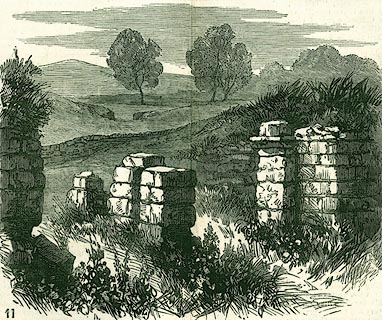 click to enlarge
click to enlargePR0314.jpg
Illustrations of place visited by the Royal Archaeological Institute.
item:- Dove Cottage : 2008.107.314
Image © see bottom of page
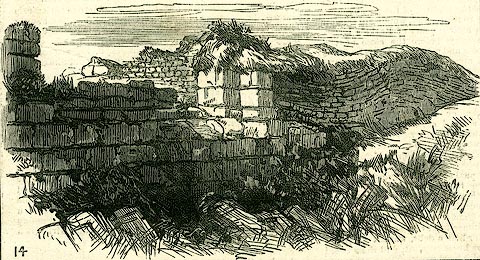 click to enlarge
click to enlargePR0315.jpg
Illustrations of place visited by the Royal Archaeological Institute.
item:- Dove Cottage : 2008.107.315
Image © see bottom of page
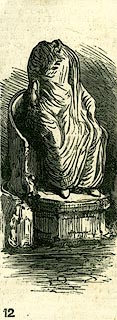 click to enlarge
click to enlargePR0316.jpg
Illustrations of place visited by the Royal Archaeological Institute.
item:- Dove Cottage : 2008.107.316
Image © see bottom of page
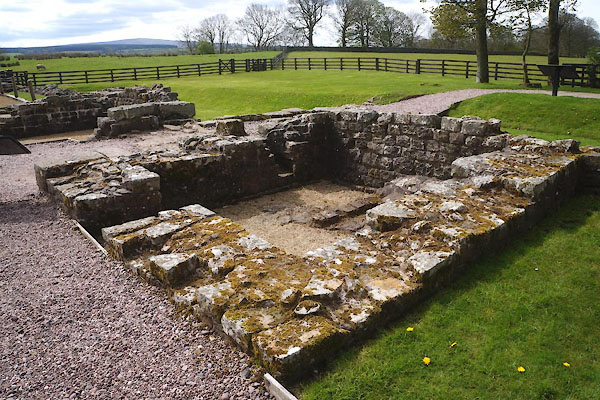
CCY73.jpg Building remains.
(taken 8.5.2015)
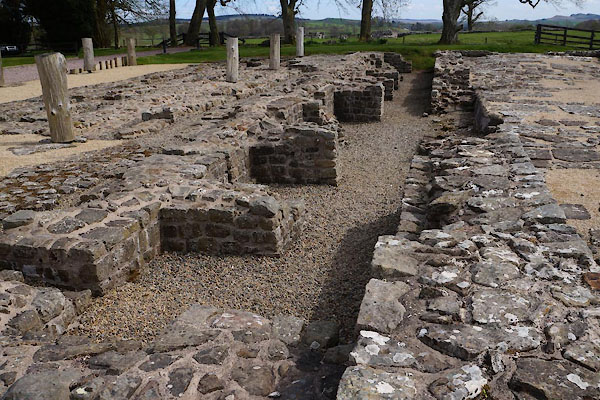
CCY74.jpg Building remains.
(taken 8.5.2015)
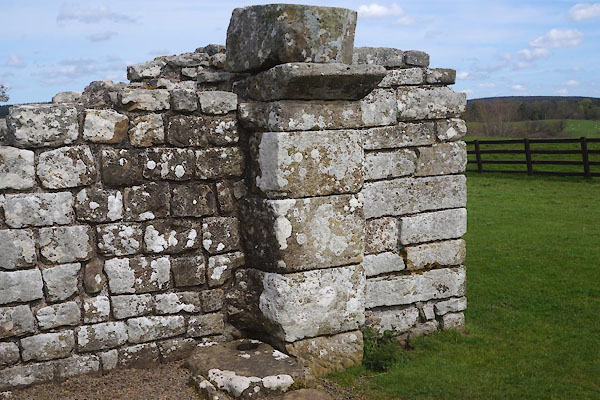
CCY75.jpg East gate, detail.
(taken 8.5.2015)
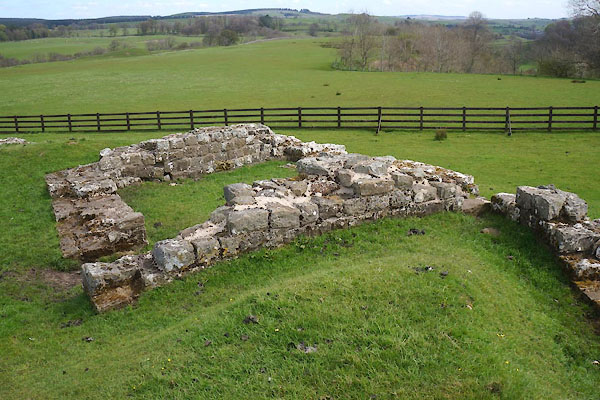
CCY76.jpg SE corner.
(taken 8.5.2015)
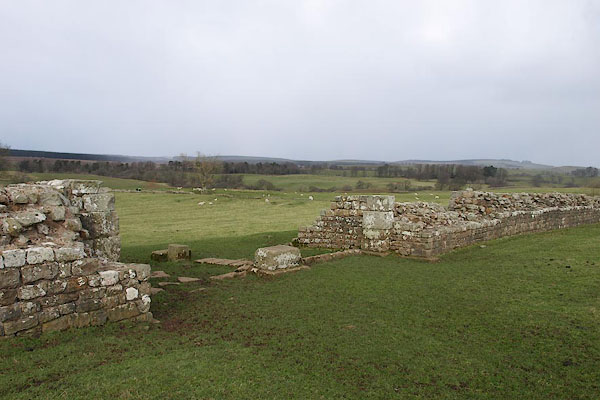
BOW16.jpg South gate
(taken 21.3.2008)
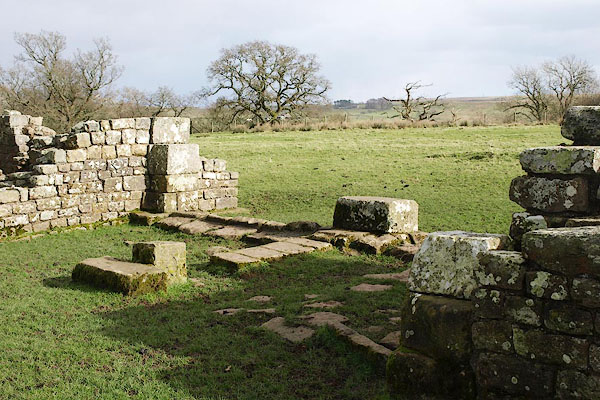
BOW15.jpg South gate.
(taken 21.3.2008)
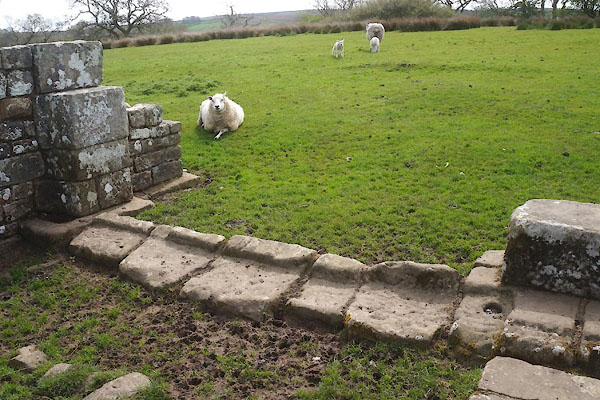
CCY77.jpg South gate, detail.
(taken 8.5.2015)
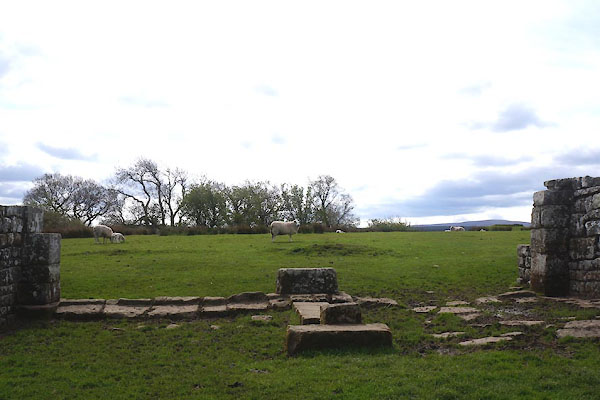
CCY78.jpg South gate, out to Maiden Way?
(taken 8.5.2015)
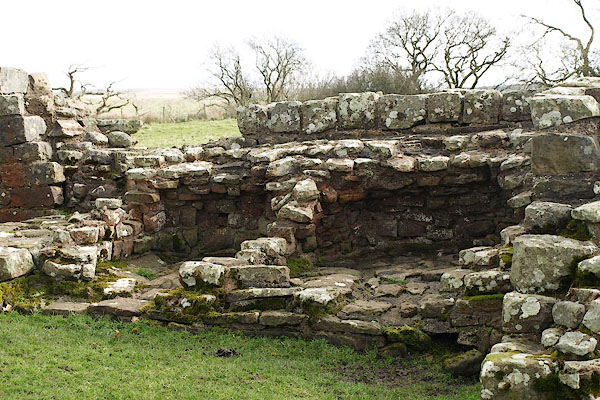
BOW14.jpg Ovens at the south gate, when guard chamber was converted to a bake house.
(taken 21.3.2008)
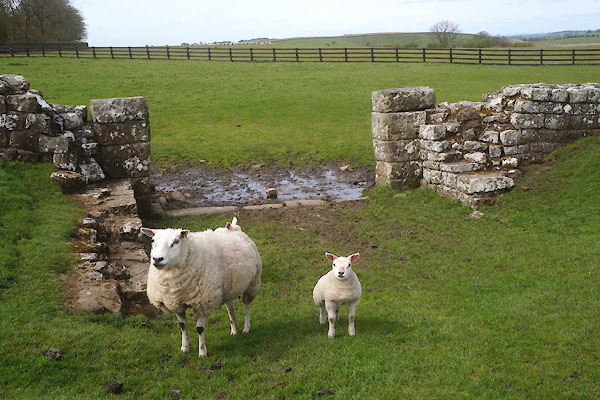
CCY79.jpg West gate.
(taken 8.5.2015)

CCY80.jpg West wall.
(taken 8.5.2015)
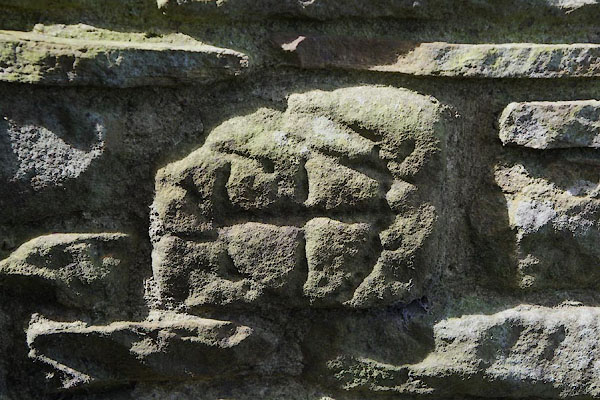
CCY65.jpg Centurial stone, built into the ticket office.
(taken 8.5.2015)
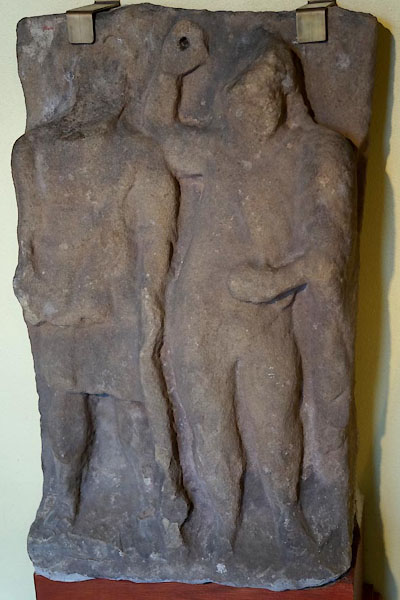
CCY61.jpg Carving, Hercules and Jupiter, found 1821.
(taken 8.5.2015)
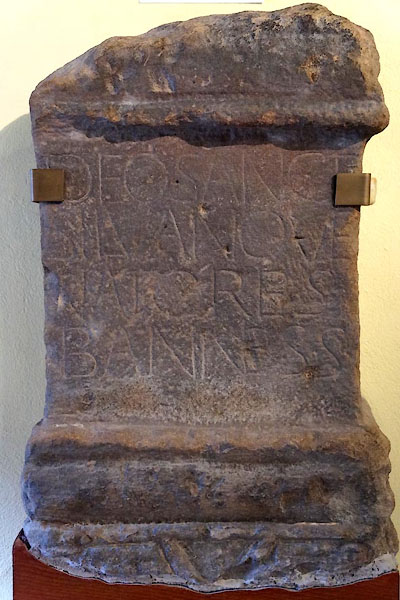
CCY62.jpg Roman altar; inscribed:-
"DEO SANCTO / SILVANUS UE / NATORES / BANNIESS" "to the god Silvanus. The 'Venatores, hunters of Banna, an irregular garrison in the 3rd century." (taken 21.3.2008)
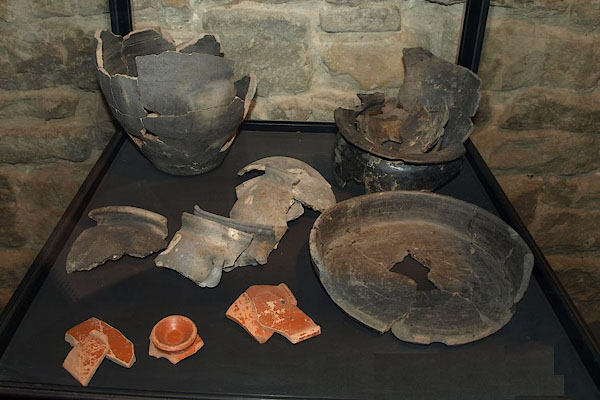
BOW19.jpg Greyware and samian ware excavated on site.
(taken 21.3.2008)
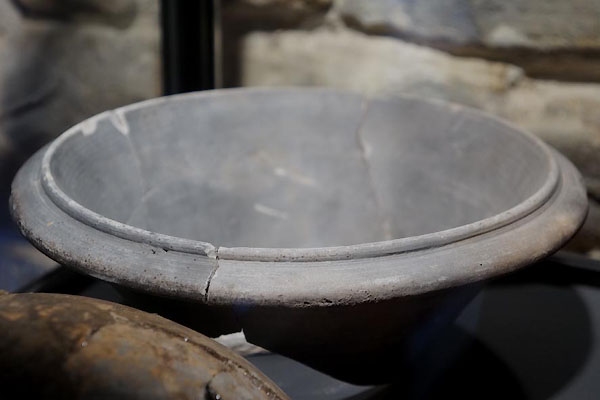
CCY63.jpg Mortarium.
(taken 8.5.2015)
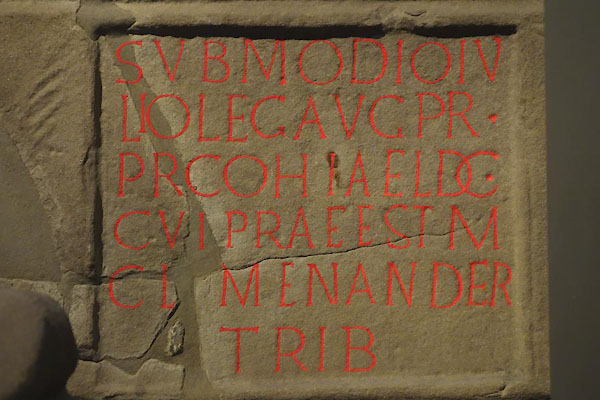
BZT83.jpg Inscription. Item 1855.7
(taken 10.1.2014) courtesy of the Hancock Museum, Newcastle.
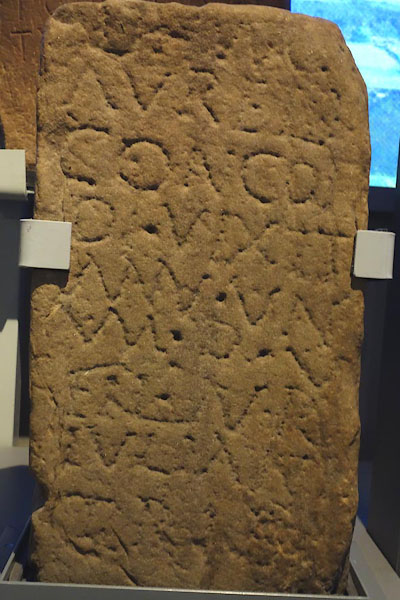
BZT85.jpg Tombstone for the baby son of Aurelius Julianus. Item 1969.28.
(taken 10.1.2014) courtesy of the Hancock Museum, Newcastle.
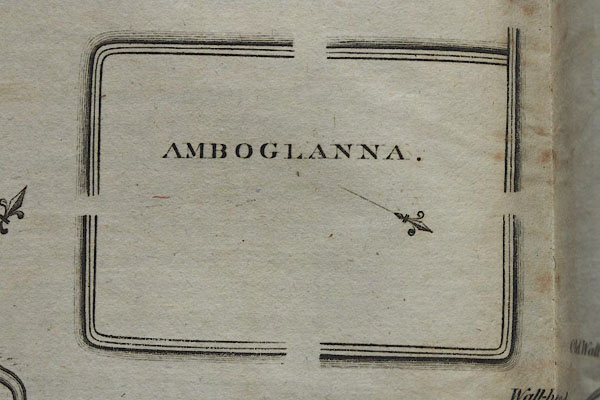
BOX02.jpg From Hutchinson 1794 map 2.
"AMBOGLANNA."
